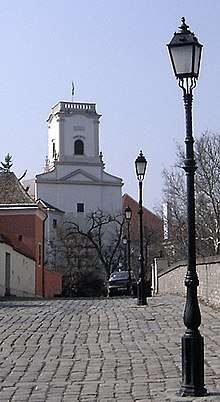Artolf
Artolf, also Aistulf, Arnolphus or Atolf (died 1252) was a Hungarian prelate in the first half of the 13th century, who served as Bishop of Transylvania from 1244 to 1245, then Bishop of Győr from 1245 until his death.
Artolf | |
|---|---|
| Bishop of Győr | |
| Appointed | 1245 |
| Term ended | 1252 |
| Predecessor | Benedict Osl |
| Successor | Amadeus Pok |
| Other posts | Bishop of Transylvania |
| Personal details | |
| Died | 1252 |
| Nationality | Hungarian |
Biography

Artolf (or Artolph) was born into an unidentified wealthy Hungarian noble family, which possessed large-scale landholdings in Transdanubia. The Schematizmus dioecesis Jauriensis refers to him as Artolf and Aistulf, simultaneously,[1] while other documents also mention the name variants of Arnolphus and Atolf.[2] Artolf was an educated prelate and skilled in theology and science.[3] He was styled as provost of Vác in 1237.[2]
Artolf was appointed Bishop of Transylvania around June 1244 by Béla IV of Hungary, who filled the dignity after a three-year period vacancy, which lasted from the death of Raynald of Belleville, who was killed in the Battle of Mohi on 11 April 1241.[4] During their invasion, the Mongols completely devastated and perished the province of Transylvania, along with its diocese and church property (including the cathedral). Artolf's task was to begin the restoration of the diocese's administrative and financial positions, but the lack of local knowledge and the shocking experience of the destruction exceeded his suitability.[5]
Around September 1245, the cathedral chapter of Győr elected Artolf as their bishop.[6] Leaving the remote and war-torn Transylvania, he pleased to occupy the position, as the several lands of his family laid in the territory of the diocese. King Béla IV interceded Pope Innocent IV in order to transfer Artolf from Transylvania to Győr. The monarch called his protege as "popular, clean-lived, educated and principled", while argued, "the army of his powerful and influential kinship will be useful for the Crown against the hostile raids at the western boundaries of the kingdom". The remark obviously referred to the emerging tension between Béla IV and Frederick the Quarrelsome, Duke of Austria.[7] The pope contributed to the change and translated Artolf to the Diocese of Győr on 12 December 1245.[2] Artolf's bishopric became a buffer zone between the Kingdom of Hungary and the Duchy of Austria in the upcoming years. He was responsible for to protect the frontier in Western Hungary.[8] It is presumable that Artolf built the tower of the episcopal castle of Győr.[2] Artolf was last mentioned as a living person by contemporary records in November 1251.[6] He died in 1252.[2]
References
- Győri 2008, pp. 25, 39.
- Diós 1993, p. 288.
- Győri 2008, p. 26.
- Zsoldos 2011, p. 89.
- Temesváry 1922, pp. 38–39.
- Zsoldos 2011, p. 91.
- Győri 2008, p. 28.
- Győri 2008, p. 31.
Sources
- Diós, István (1993). Magyar katolikus lexikon [Hungarian Catholic Lexicon] Vol. I (in Hungarian). Szent István Kiadó. ISBN 963-3607-18-3.CS1 maint: ref=harv (link)
- Győri, Éva (2008). "Győri püspökök a XIII. században [The Bishops of Győr in the 13th Century]". Belvedere (in Hungarian). 20 (1–2): 24–43. ISSN 1419-0222.CS1 maint: ref=harv (link)
- Temesváry, János (1922). Erdély középkori püspökei [Medieval Bishops of Transylvania] (in Hungarian). Minerva Irodalmi és Nyomdai Műintézet.CS1 maint: ref=harv (link)
- Zsoldos, Attila (2011). Magyarország világi archontológiája, 1000–1301 [Secular Archontology of Hungary, 1000–1301] (in Hungarian). História, MTA Történettudományi Intézete. ISBN 978-963-9627-38-3.CS1 maint: ref=harv (link)
| Catholic Church titles | ||
|---|---|---|
| Previous: Raynald of Belleville |
Bishop of Transylvania 1244–1245 |
Succeeded by Gallus |
| Preceded by Benedict Osl |
Bishop of Győr 1245–1252 |
Succeeded by Amadeus Pok |